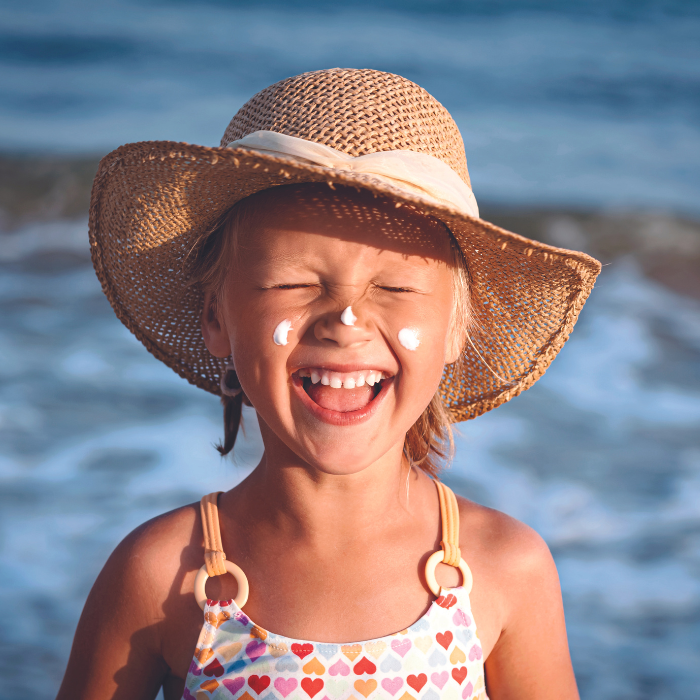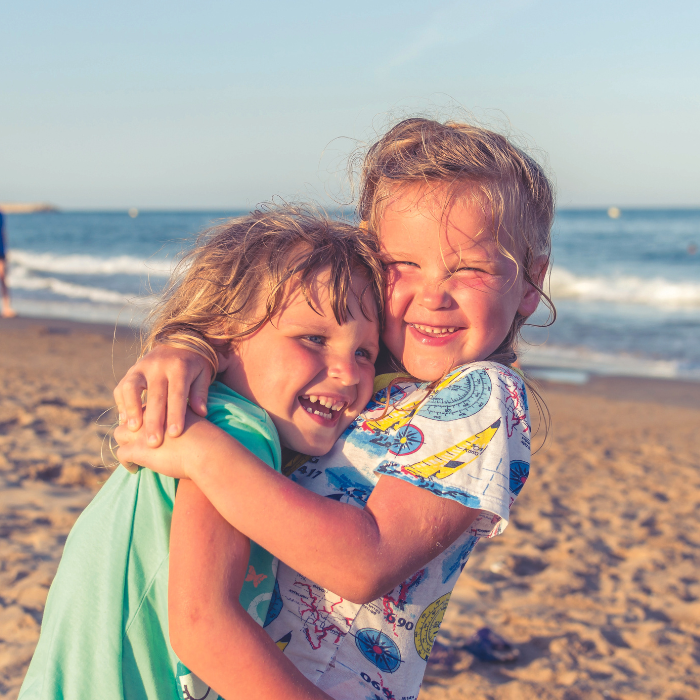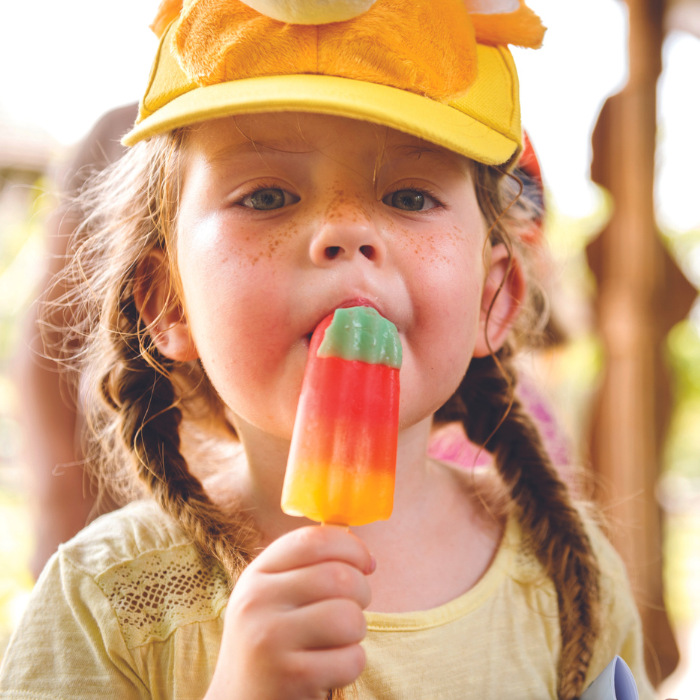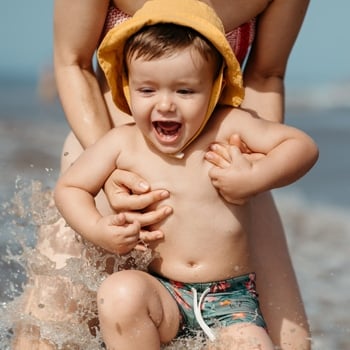
Plan ahead and have peace of mind with these safety tips from Tiffany Brown.
The lowdown on lathering up
The extent to which children need protection from the sun depends on their skin type, as well as their summertime activities. According to the Fitzpatrick scale there are six main skin types, with Type 1 being the very fairest person likely to burn at the drop of a hat, through to Type 6, a very dark-skinned person whose skin offers a ton of protection from the sun before it’s likely to develop a burn.
The sliding scale between our varied skin types should inform how we deal with sun protection, because while it’s really important to protect delicate young skin from sunburn, it’s also important to ensure kids get some vitamin D all year round. Vitamin D is efficiently made by our skin in response to sunlight, and again this varies according to our skin type. Darker skinned people are at higher risk of vitamin D deficiency and need longer periods of exposure to the sun to make vitamin D. When the UV index is high during hot summer days, let the kids have a quick runaround in the early morning or late afternoon without sunscreen. Very fair skins only need about five minutes of exposure to make sufficient vitamin D while dark skins may need up to 30 minutes per day.
Always use sunscreen if swimming, boating or doing any other water activities. Water reflects 80 per cent of the environmental ultraviolet light, and magnifies your exposure. Kids should also lather up when playing sports or if they are otherwise unshaded or unable to wear a hat or protective clothing. Shade and clothing should be a first line of defence, with sunscreen used when sun exposure exceeds the safe limit for your child’s skin type. Be wary of the false sense of security overcast days bring too; we can be more likely to sunburn on days with cloud cover because we don’t experience the same warning signals as the skin heats up and pinks up in response to sunshine. True sunburn will usually appear on the skin until around 6-12 hours after the excessive exposure occurs, although the skin may feel hot and kids may be irritable, complain of dizziness or headache or be very thirsty following too much sun. Aloe vera is a wonderful natural healing ingredient used in plenty of after-sun products; you can also snap off a branch directly from a plant and rub the juice onto affected skin. Heat stroke, also known as sunstroke, is a severe heat reaction which raises the body temperature greater than 40 degrees Celsius and causes confusion, red skin, headache and dizziness. During the hot periods of the year, it is really important to ensure that your air conditioning is working efficiently so that if you do need repairs from somewhere like npmheatingandcooling.com/ac-repairs-in-weldon-spring/ you can get it fixed quickly and ready for when you need relief from the sun. However, if you do suspect sunstroke, place your child in a tub or bath of cold water and call for help. Heatstroke is a serious condition that usually requires medical attention, so don’t be afraid to call 111 for assistance.
Water confidence is cool
The leading cause of drowning is an inability to swim properly for the conditions, so it makes good sense to ensure your children learn good swimming skills before heading out to enjoy water activities over summer. Confidence in the water is crucial for children to stay safe while making the most of their time at pools, rivers or beaches. You must always supervise your children around water. Floating aids can be great fun and help children build swimming skills, but they’re no substitute for an accompanying adult swimmer if your child isn’t yet water-safe. If you are not a strong swimmer yourself, take some lessons too, because you won’t be much good to a child in trouble in the water if you are not able to manage yourself first. Kiwis are blessed with a wonderful variety of waterways to enjoy, but conditions can change rapidly. Water that looks calm can mask rips and currents to challenge even strong swimmers. If a beach has lifeguards, make sure you swim between the flags. The flagged area is under constant watch and the safest place to enjoy the water. If you or your child does get into trouble, try to stay calm and raise a hand into the air to alert lifeguards you need assistance. If swimming in a river, watch for hazards and never jump or dive in without knowing the depth or what’s underneath the surface. If you do get caught in a river’s current, don’t fight it, but stay calm and float downstream until you reach a landing space. Swimming pools can be surrounded by slippery decks or tiles, so make sure your children know not to run around the edge.
Deal with the itchy scratchies
Enjoying the outdoors during summer and getting up close to nature goes hand-in-hand with a number of extra hazards, so make sure you prepare your first aid kit. Insect bites are the most common culprit, with sandflies, mites, mosquitoes, bees and wasps swarming in greater numbers than they do in the cooler months. Children spend more time outdoors during summer and the cooling evening is often when the biters come out to play, but can’t be felt or seen. An insect bite usually forms a red, itchy bump on the skin, possibly with a blister in the centre.
As bites are often itchy, children may scratch at them and break the surface of the bite, which can then become infected. Otherwise the bites usually subside in a few days. Some people are more susceptible to bites than others, which could be due to chemical compounds in our skin that create a certain smell the flying biters enjoy. Try spreading some smell-disrupting essential oil-based spray or lotion on your kids’ skin if they tend to get bitten; rosemary, peppermint, tea tree and eucalyptus are all great choices.
If bitten, soothe the redness with cold or ice compresses. There are plenty of retail options available, or make a DIY version with a direct application of any one of these proven natural remedies: oatmeal, honey, aloe vera, basil, vinegar, onion, thyme, lemon balm, witch hazel, chamomile tea or garlic. At the beach, kids can be in danger of picking up a jellyfish sting. These are not usually serious but even still can cause intense pain, redness, a burning sensation or itching.
If your child experiences a sting, wash the area with seawater, then wait five minutes before wiping off any tentacles with a dry towel, taking care not to touch them. You can apply an ice pack to the area but don’t apply vinegar or alcohol; these will make the sting worse. In New Zealand we also have a stinging seawater creature called a blue bottle, or Portuguese man-of-war. These can give nasty bites like jellyfish, but the treatment is slightly different. Wash the affected area with sea water (never fresh water, as it will worsen the sting) and wait five minutes before wiping tentacles off with a dry towel, then soak the affected area in warm water for 20 minutes. The blue bottle sting should be gone by then, but if not, seek medical assistance.
Really good roadies
A Kiwi summer holiday often includes a road trip or two, and never more so than the summer ahead of us. Keep the family safe while you travel on the road by maintaining an awareness of the changes out on the roads during the holidays. There could be a lot more traffic on the road and you may be on unfamiliar terrain, so try not to be in too much of a hurry and give others plenty of space. You’ll need patience with added stress factors at an all-time high, like excited kids in the back, traffic jams, fatigue and heat. It’s holiday time, isn’t it? So why not stretch your journey out by making some interesting pit stops at points of interest? Most kids love the excitement of stopping at fun places, and they’ll be more settled for the boring parts of the journey if they’ve had a chance to stretch their legs and enjoy some new spaces.
You could plan your journey outside of the busiest travel times; as long as the driver has an early night and is well rested, you could bundle the kids into the back seat in their pyjamas and steal away in the early dawn at 4 or 5am. There’s a chance they’ll fall back to sleep in the car, and you’ll get a good chunk of the driving done before they’re fully awake. The same idea can be used at the end of the evening. Driving to the conditions is crucial during the holidays, and this isn’t only about the weather. Check nzta.gov.nz for any highway updates en route and ensure your vehicle is fit for the road.
If you’re towing a camping trailer, caravan or boat you need to be especially vigilant. The maximum speed while towing is 90kmph and you need to look for every opportunity to pull to the left and let other drivers pass you where possible. Most of all, try to maintain a happy vibe for the family (and the driver) when you’re travelling. Why not appoint a Captain Holiday to be in charge of reminding everyone to smile and have fun? Sure, it may be there’s only one family member really suited to that role… but you never know… do it often enough and it might just catch on.








